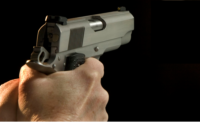Employers can issue policies and post signs prohibiting guns at the workplace. But it is naïve for safety pros to believe that no one nearby has a concealed gun. Following the mass shooting at the Sandy Hook Elementary School in Connecticut in December 2012, the Montpelier, Ohio, school board in January of this year unanimously approved for janitorial staff to carry guns provided they pass requirements for Ohio’s Concealed Carry Permit (CCP) law. Ohio’s CCP law requires 12 hours of safety training: ten in the classroom and two firing the gun.
View more articles about workplace violence
At a lunch meeting a several years back, a fellow safety pro whispered to me that she obtained a CCP. She confided in me about her intent to pack heat because I served in the United States Marine Corps. Marines understand guns and she wanted my opinion on her actions.
I had no problem with her packing heat. Her safety job took her into many seedy locations at odd hours. I suggested that a handgun may be viewed as PPE that levels the playing field if a bad guy intends to do her wrong. The National Rifle Association’s logic is the “only way to stop a bad guy with a gun, is a good guy with a gun.” I did, however, advise her to conceal her opinion on guns so that her character is not falsely judged by lovers and haters on this topic.
Active shooter
What would you do if confronted by an “active shooter”?
An active shooter is defined by the U.S. Department of Homeland Security as “an individual actively engaged in killing or attempting to kill people in a confined and populated area; in most cases, active shooters use firearm[s] and there is no pattern or method to their selection of victims.”
The Department of Homeland Security developed a website in January 2013 that provides all necessary training materials to deal with an active shooter. At a minimum, all workplaces should show employees the YouTube training video on response to an active shooter and provide employees with the Active Shooter Pocket Card.
The DHS card advises you to be aware of your environment and any possible dangers. Take note of the two nearest exits in any facility you visit. If you are in an office, stay there and secure the door. Call 911 when it is safe to do so. Attempt to take the active shooter down as a last resort.
Evacuate and hide and cover are key responses when an active shooter is in your vicinity. The DHS lists a third option as a last resort, and only when your life is in imminent danger, attempt to disrupt and/or incapacitate the active shooter by:
(1) Acting as aggressively as possible against him/her; (2) Throwing items and improvising weapons; (3) Yelling; and (4) Committing to your actions.
Slippery slope
Everyone should know that last resort actions will have minimal effect when bullets fly their way. Employers stand at a slippery slope when they address the DHS’s third option. How far should employees be trained on aggressive actions and improvising weapons?
This brings us back to the NRA’s logic that the “only way to stop a bad guy with a gun, is a good guy with a gun.” Employees with command and discipline authority, such as HR managers and foremen, are often the first to encounter an active shooter in the workplace. Should these employees be allowed to obtain a CCP and carry a concealed handgun, their special PPE, at the workplace?
Insurers will tell employers that handguns at work are a bad idea. Many insurers, however, take this position to shield their liability loss. But how far should someone go to prevent loss of their life? Some employers may argue that a CCP for certain employees acts as a deterrent. Maybe a bad guy with a gun won’t confront a good guy with a gun.
Statistics
Statistics shed light on who the “bad guys” may be in workplace shootings.
From 2004-08, an average of 564 work-related homicides occurred each year in the United States, according to the Bureau of Labor Statistics. In 2008, a total of 526 workplace homicides occurred, or 10 percent of all fatal work injuries. About 4 out of every 5 homicide victims in 2008 were male. The type of assailants in these cases differed for men and women. Robbers and other assailants made up 72 percent of assailants for men, and 51 percent of assailants for women. Relatives and other personal acquaintances accounted for only 4 percent of assailants of homicides for men, but 28 percent for women, according to the BLS.
In 2008 there were 30 multiple-fatality workplace homicide incidents, accounting for 67 homicides and 7 suicides. On average, about two people died in each of these incidents.
Shootings accounted for 80 percent of all homicides in 2008 (421 fatal injuries). Co-workers and former co-workers were the assailants in 12 percent of all shootings. Robbers were the assailants in another 40 percent of cases in 2008. Nearly half of these shootings (48 percent) occurred in public buildings, thereby endangering bystanders.
Sales and related occupations accounted for 26 percent of decedents in shootings. Most shootings occurred in the private sector (86 percent) whereas 14 percent of shootings occurred in government. Of the shootings within the private sector, 88 percent occurred within service-providing industries, mostly in trade, transportation and utilities.
Battle of experts
Experts aplenty line up on both sides of the CCP at work debate. Employers and safety pros must understand the debate will not ebb, particularly with the U.S. gun culture. Fair disclosure: I don’t have or want a CCP. I am, however, certified by the NRA as a CCP and personal protection in the home instructor. You may wrestle with that dichotomy and try to judge my character. This topic deserves first-hand knowledge of what’s going on and how best to address the contentious debate on personal use of guns in America



